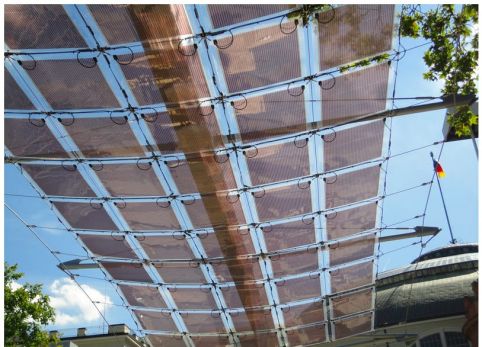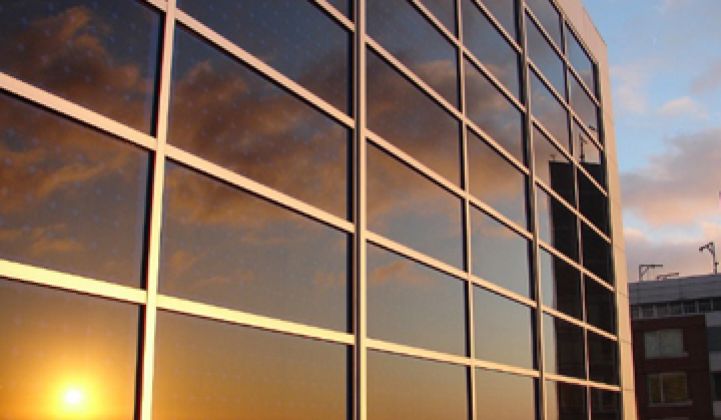Talk of building-integrated photovoltaics (BIPV), or coating window glass with PV materials, typically occurs when a solar startup is running on fumes or a charlatan is in the room. (Here's a BIPV effort from Abound Solar and eIQ electronics, now both defunct.)
The BIPV I speak of is not the building-applied photovoltaics from the likes of Lumeta or Global Solar or SoloPower or Hanergy's MiaSolé. Instead, the term "BIPV" refers to solar power sources that are an integral, structural part of the building envelope or facade.
That's the market Germany's Belectric, a solar developer, financier, and construction firm, is targeting with the organic photovoltaic technology it acquired from Konarka and its new partnership with flat-glass processor BGT Bischoff Glastechnik.
Belectric has deployed more than 1 gigawatt of solar. The company's OPV Director of Business Development, Marketing and Sales, Hermann Issa, said in a release, “If solar energy is to be used throughout the entire building shell, then organic photovoltaics are extremely well suited to this purpose."
Organic solar cells (OSCs), sometimes referred to as third-generation solar, hold the promise of low-cost production, but their efficiencies tend to be very low. Hero cells are nudging 12 percent efficiency, but long-term reliability and degradation issues remain common with the technology. These low efficiencies have left OSCs to niche applications such as portable electronics, automotive, and the promised-land market of BIPV, which includes windows and facades, as well as concrete and other building materials. There are also potential military applications.
One of the appeals of third-generation thin-film solar cells is that they can be manufactured using solution-based, low-temperature, roll-to-roll manufacturing methods, using conventional printing techniques on flexible substrates. That is the siren song that has kept a trickle of funding flowing.
Organic and dye-sensitized solar cell developers include Dyesol, Heliatek, Solarmer, Plextronics, EPFL, Mitsubishi, Peccell, and G24i. Dyesol builds equipment to manufacture dye-sensitized solar cells (DSSCs). Eight19 Limited raised $7 million from the Carbon Trust and Rhodia to develop plastic organic solar cells. Ireland's SolarPrint has replaced the liquid part of the DSSC with printed nanomaterials. Intel has done some research into OSCs, as well.
Record cell efficiencies for OSCs and DSSCs, as per NREL

So far, organic solar cell technology has not been able to achieve commercialization.
Success has also eluded BIPV.
Here's why: BIPV design has to start at building conception -- it can't be solar panels slapped on the side of a structure. Instead, the specs for PV curtain wall and facades must stem from architects and building designers, and in many cases, these folks are artistes who will not settle for allowing the standard-sized solar panel dimension to define the size of their window. That will require custom-size panels or numerous custom sizes. Production line processes cannot support that level of customization economically. And if each custom size requires a separate UL approval process, the applicant will be faced with a long, expensive relationship with Underwriters Labs.
Because of those factors, and despite forecasts to the contrary, the BIPV market will remain the domain of custom work and demonstration projects in a difficult-to-standardize market with poor economies of scale. There are opportunities in BIPV (maybe not with OSCs), but the expertise and channel to the customer will come from the curtain wall and building trade, not from the solar industry.




